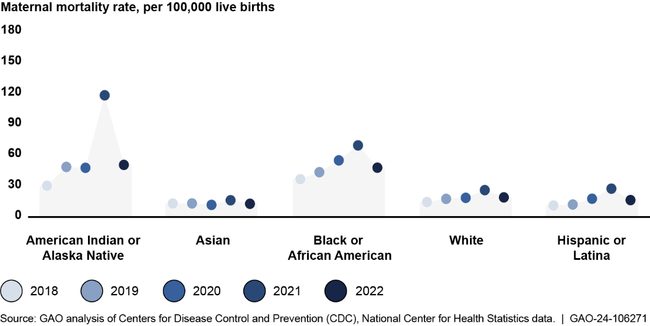Maternal Health: HHS Should Improve Assessment of Efforts to Address Worsening Outcomes

[ad_1]
What GAO Found
Maternal mortality and other adverse outcomes associated with pregnancy or childbirth worsened significantly in 2020 and 2021, as compared with 2018 and 2019, according to Department of Health and Human Services (HHS) data. Disparities in maternal health outcomes persisted during the pandemic for certain groups. For example, the maternal mortality rate among non-Hispanic, Black or African American women was about 2.5 times greater than non-Hispanic, White women during these years, according to GAO’s analysis of HHS data.
Maternal Mortality by Race and Ethnicity, 2018 – 2022

Notes: A maternal death is the death of a woman that occurs during or within 42 days of pregnancy from any cause related to or aggravated by the pregnancy or its management. All racial groups are not Hispanic or Latina; Hispanic or Latina women may be of any race.
The White House Blueprint for Addressing the Maternal Health Crisis was released in June 2022 in response to worsening outcomes and disparities. It highlights specific federal actions and outlines long-term goals for improving maternal health. HHS offices intend to develop a strategy for assessing the performance of these long-term goals. However, as of September 2023, HHS had not indicated whether the strategy will include key practices, such as establishing near-term goals and performance measures, to track the performance of their efforts . Doing so would allow HHS to better assess its efforts to improve maternal health.
The blueprint also identifies key maternal health efforts, such as the Centers for Disease Control and Prevention’s (CDC) Perinatal Quality Collaborative program, which supports multidisciplinary teams implementing maternal health quality improvement initiatives. The CDC program has both long- and near-term goals, but the near-term goals lack quantitative targets, such as targets specifying the anticipated number of facilities participating in the Perinatal Quality Collaborative program. Establishing such targets would allow CDC to assess the program’s progress to help improve maternal health outcomes.
Why GAO Did This Study
The U.S. is experiencing a maternal health crisis: it has one of the highest maternal mortality rates among high-income nations; increasing rates of complications from pregnancy or childbirth; and persistent disparities in such outcomes, according to HHS. GAO previously reported that the COVID-19 pandemic exacerbated maternal health outcomes and highlighted racial disparities.
The CARES Act includes a provision for GAO to report on its COVID-19 pandemic oversight efforts. GAO was also asked to review maternal health during the pandemic. Among other things, this report describes what available HHS data show about maternal health during COVID-19, and examines the extent to which HHS agencies have incorporated key practices to assess the performance of selected HHS maternal health efforts. GAO selected efforts based on factors such as the number of states in which teams implement the efforts. GAO reviewed HHS data for various years from 2016 through 2022 (based on availability), reviewed agency documentation, compared efforts against key practices, and interviewed HHS officials and stakeholders.
[ad_2]
Source link
